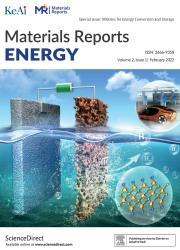可充电锌离子电池溶剂化护套的研制进展与展望
IF 13.8
引用次数: 0
摘要
金属锌水溶液电池(azmb)完美地结合了安全性、经济性和环保性,但由于[Zn(H2O)6]2+的脱溶能势大和活性水在电解质/电极界面的大量释放而导致界面不稳定,限制了其性能。本文简要介绍了锌离子的溶剂化结构及溶剂化的必要性。随后,对解决这些问题的各种策略进行了分类和系统的总结,主要包括通过改变电解质环境来重组溶剂化鞘和通过构建人工界面层来加速界面脱溶。同时,从脱溶理论、界面演化、材料设计和分析技术等方面对高稳定性锌阳极的设计提出了展望和建议。本文章由计算机程序翻译,如有差异,请以英文原文为准。

Tailoring solvation sheath for rechargeable zinc-ion batteries: Progress and prospect
Aqueous zinc-metal based batteries (AZMBs) perfectly combine safety, economy and pro-environment, but their performance is arresting limited by the interfacial instability caused by the large desolvation energy barrier of [Zn(H2O)6]2+ and the massive release of active water at the electrolyte/electrode interface. In this review, we briefly outline the solvation structure of zinc ions and the necessity of desolvation. Subsequently, the variety of strategies to solve these issues, mainly including reorganizing solvation sheath by changing electrolyte environment and accelerating interface desolvation by constructing artificial interfacial layer, are categorically discussed and systematically summarized. Meanwhile, perspectives and suggestions regarding desolvation theories, interfacial evolution, material design and analysis techniques are proposed to design highly stable zinc anodes.
求助全文
通过发布文献求助,成功后即可免费获取论文全文。
去求助
来源期刊

材料导报:能源(英文)
Renewable Energy, Sustainability and the Environment, Nanotechnology
CiteScore
13.00
自引率
0.00%
发文量
0
审稿时长
50 days
 求助内容:
求助内容: 应助结果提醒方式:
应助结果提醒方式:


